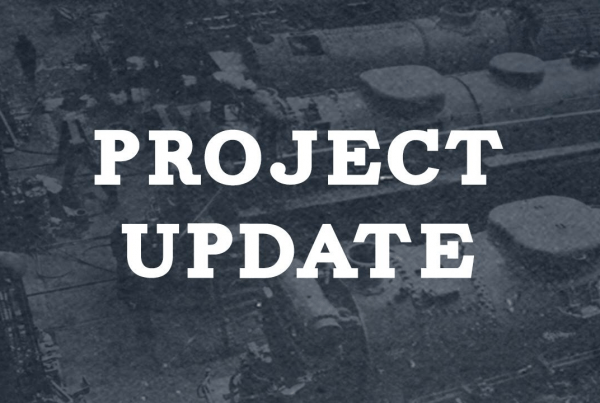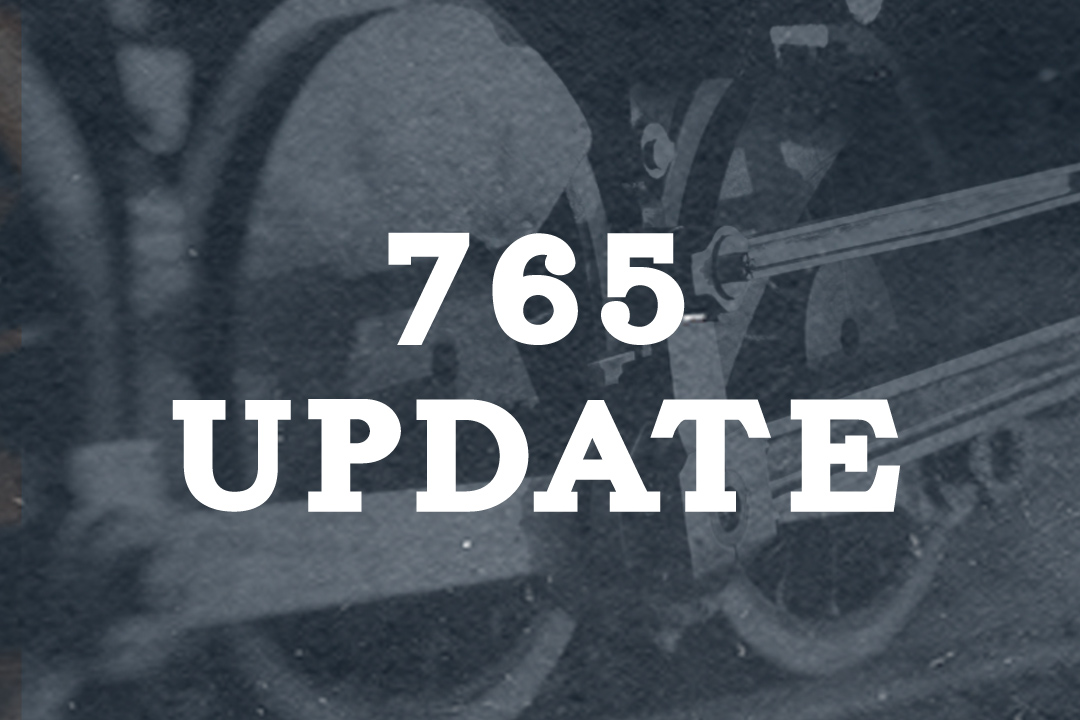Submitted by Steve Winicker.
LAST WEEKENDS SHOP ACTIVITY
Friday Zach Hall got things going early in fact he got them going on Thursday. In any case the pedestal liners were shimmed and in place by the end of the day. We test fit one of the wheel sets but did not have enough horsepower to lift the other into place. The drawbars were painted, and the drawbar pins cleaned.
Saturday, we had a good crowd of workers to start the day. The trailing truck was turned right side up by Jerrad and the truck crane. By the way the truck crane is sporting 10 new tires and rims more new rubber than has been on the property in years. (thanks to a donation from Thanks to McMahon’s Tire) With a lot of effort and using both the shop crane and forklifts the truck frame was set on it wheels and springs and equalizers installed, some twice both backward and forward. [It’s not that we do this out of ignorance we like working on this stuff and so doing it twice is just twice the fun.] In any case by the end of the day the truck was back together, and several pallets loads of parts disappeared, with none but the replaced worn parts left. Final shimming and other adjustments will be done once the truck is back under the engine. Matt and Broady started to work on straightening the ash pan. Then we quit for the day.
Sunday, with the assistance of George in finding a rosebud torch, though not the good one, we managed to heat up the bent water pipe bracket and put it back to where it was supposed to be. We also worked on straightening out the ash pan with some success, but more work is needed. I got the pipe brackets apart for the remaining lubrication piping so we can move ahead on getting the piping on and tightened next weekend.
UPCOMING ACTIVITIES
Next week we need to clean out the shop so Fruchey can get in and lift the locomotive. We also need to finish the lubrication lines on the truck and paint the inside of the truck as it will be less accessible once together. If time and personnel permit, we may work on the ash pan some more.
SAFETY SENSE
Every day an estimated 1,000 eye injuries occur in American workplaces. No matter where we work, flying particles, dusts, splashes or flying objects are apt to expose us to potential eye injury. Fortunately, we can protect against these hazards by using the appropriate protective eyewear for our jobs.
A survey by the Bureau of Labor Statistics (BLS) of about 1,000 minor eye injuries reveals how and why many on-the-job accidents occur….
· Not wearing any eye protection. Nearly three out of every five workers injured were not wearing eye protection at the time of the accident.
· Wearing the wrong kind of eye protection for the job. About 40 of the injured workers were wearing some form of eye protection when the accident occurred. These workers were most likely to be wearing eyeglasses with no side shields, though injuries among employees wearing full-cup or flat-fold side shields occurred, as well.
What Causes Eye Injuries?
· Flying particles. Approximately 70% of the accidents studied resulted from flying or falling objects or sparks striking the eye. Injured workers estimated that nearly three-fifths of the objects were smaller than a pin head. Most of the particles were said to be traveling faster than a hand-thrown object when the accident occurred.
· Contact with chemicals caused one-fifth of the injuries.
· Other accidents were caused by objects swinging from a fixed or attached position, like tree limbs, ropes, chains, or tools which were pulled into the eye while the worker was using them.
There are several types of eye protection and it’s important you wear the right protection for the task.
Safety Glasses
Safety glasses with side shields are a very good form of eye protection for general use to prevent flying debris and or objects from coming into contact with your eyes.
Safety Goggles
When using compressed air sand blasting or handling harmful chemicals we need to wear safety goggles. Goggles offer superior protection from small flying debris and particles as well as chemical splashes.
Face Shields
When grinding, needle gunning, handling chemicals or changing batteries we need to wear a face shield along with our safety glasses or goggles. This gives additional protection to our face during these types of tasks.
Wearing the proper eye protection is the insurance policy you can have for protection your vision.
SAFETY IS JOB 1
SAFETY FIRST ALWAYS


